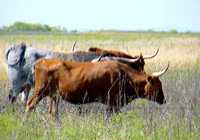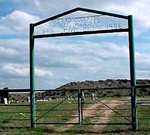Camp Springs, Scurry County, Texas. (original) (raw)

History in a Pecan Shell
Springs were the main attraction to the area, even before the settlers arrived. Indians would camp here and later, the U.S. Army would bivouac here when it explored the area or went looking for Indians.
Robert E. Lee found time to chase Comanches in the area between his stint in Mexico during the Mexican War and commanding the Southern forces during the Civil War.
The actual springs are 6/10 of a mile northwest of the historical marker on a private ranch. They form a pool about 40 ft across. There are many indications of prehistoric visitors.
In Gunnar Brune's excellent Springs of Texas, he adds a description of the springs from 1878 - including the story of the Berry family who would load up their wagon with wash tubs and dirty clothes and make the 10 mile trip to the springs. They'd boil their clothes, eat lunch and let the clothes dry on the branches of trees.
He goes on to relate how Comanches stole horses in the area and how the springs were used for Baptisms. A schoolhouse was built close to the springs and it became a meeting place for the settlers, slowly evolving into a town.
One W.H. Camp settled here, but it was some time before the community bore his name. The postmistress had a son with the rather unusual name of Afra. The Handbook of Texas Online states that: "Residents called their town Afra after the postmistresses son." Perhaps it was a case of call it Afra or get late mail.
"They later called the town Camp Springs." (Maybe after Afra moved away). The post office closed in the early 50s and in 1990 the population was given as 10 persons.

Lee Farm in Camp Springs
"My Uncle Charles Lee lives there." Charlene Beauchamp
Photo Courtesy Charlene Beatty Beauchamp, 2001
Historical Marker: From Snyder take US 180 E. to FM 1614, turn N to near Camp Springs Road.
Camp Springs
Named for W. H. Camp, an early settler who built a dugout in 1878 at springs, one-half mile northwest of here. Petrified trees—one 300 feet tall—and bones of prehistoric animals have been found in area. Tools, pictographs in nearby cave indicate Indians camped here. Emigrant trail to California, blazed in 1849 by Army Captain R. B. Marcy, came through region. General Robert E. Lee followed part of same trail searching for hostile Comanches in 1856. Both men made camp at Green Springs, six miles southwest. Post office was established, 1891.
Recorded Texas Historic Landmark, 1967.



Scurry County 1920s map showing Camp Springs
From Texas state map #10749
Courtesy Texas General Land Office
� John Troesser
Sources:
The Handbook of Texas Online
Springs of Texas Volume 1, 1981 by Gunner Brune
Texas Escapes, in its purpose to preserve historic, endangered and vanishing Texas, asks that anyone wishing to share their local history, stories, landmarks and recent or vintage photos, please contact us.
